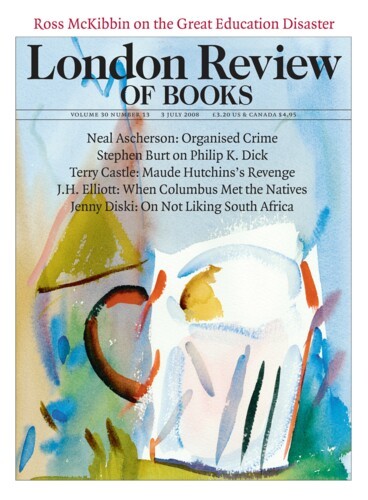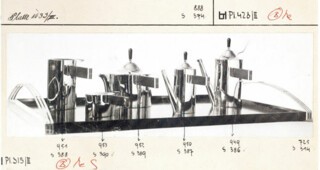The faces and bodies of the women a painter invents are objects of libidinal desire. Greuze’s indelibly stupid, infatuated girls, their eyes rolled upwards in tear-stained sentiment; Burne-Jones’s slightly anaemic young women, well-built but sorely in need of someone to tell them to stand up straight; Fuseli’s athletic dominatrixes and witchy fairies; Rubens’s images of round-cheeked, half-smiling normality; even Millet’s solid-limbed and blunt-faced peasant girls: it’s hard not to read them as embodiments of desire (women don’t seem to invent men in that way). When men paint portraits of women the facts of a face dilute the archetype. Gustav Klimt created an eloquently sinister, predatory Judith/Salome type. Her jaw is rather square, her thin mouth is a little open, her lips drawn back showing white teeth – the faces of mummies shrink into similar smiles and grimaces. Her eyelids may droop heavily or be closed. She, and her less explicitly characterised sisters, are mostly skinny, but wide-hipped. When they are naked they are often standing in frontal poses in which pubic hair is strongly accented.
In some portraits – those of Rose von Rosthorn-Friedmann and Margaret Stonborough-Wittgenstein, for example (the first of these and a study for the second are in the exhibition Gustav Klimt: Painting, Design and Modern Life, until 31 August) – a hint of the imagined type may be preserved, but the faces in his portraits are more usually little islands of conventional face painting surrounded by seas of mosaic-like pattern or vague broken colour. Sometimes the backgrounds imply a flat, decorated wall, sometimes a cloudy space. In his landscapes, the trees, hillsides and meadows are represented by swathes of flat floral decoration – as though the picture had been draped in Liberty print.
This tendency to replace fictive space with overall patterned surface can be related to general changes in the art of painting after photography. With Klimt, however, the strong link is to craft, and to the designers, decorators and architects with whom he worked – in the frieze he designed for the Palais Stoclet in Brussels the collaboration with the Wiener Werkstätte was very close. He shared with the makers of the silverware, furniture, architecture, clothes and interior design that provide the Liverpool show’s second strand the idea of the house as an integrated work of art. His portraits link Klimt firmly with the handful of wealthy families whose patronage of both the painter and the designers, architects and craftspeople of the Vienna Secession, made it possible for that ideal to be realised in a few houses and apartments. Karl Wittgenstein, Ludwig Wittgenstein’s father, was one of the most generous. He bought the products of the Wiener Werkstätte, contributed financially to Olbrich’s Secession building, collected Klimts and commissioned pictures, like the portrait of his daughter, from him.
There is a photograph of Margaret in the exhibition, taken around 1931 – 25 years after the portrait was painted – that makes you think about things addressed in the catalogue, but only implied in the exhibition. It shows a gathering in the house her brother Ludwig designed for her in the mid-1920s. He slouches in the middle of the picture, almost obscured by the flowers of a spectacularly healthy cyclamen. A silver tea and coffee service designed by Josef Hoffmann can be seen on one of the little tables in the foreground. That silverware, produced by the Wiener Werkstätte in 1904-5, can also be seen in a photograph of the flat the couple had in Berlin. The room in the 1931 photograph is not at all like the one in the Berlin apartment – the architectural space, as other sources make plain, was much more severe and without decoration. Photographs of the house, unfurnished, show a considered geometry that must have been masked by the upholstered chairs the group are sitting on, and the teacups, flowers and cushions.
The silverware is stylish, the house timeless. The distinction turns up often in the fashion and furniture industries, where the timeless tends to be labelled ‘classic’. It is not a matter of price: plimsolls and espadrilles are as timeless as the welted shoe made on your own last in St James’s, the shoes Vivienne Westwood models have been known to fall off are stylish. The products of the Wiener Werkstätte were that above all. Hoffmann’s coffee pot, like many traditional ones, has a handle that sticks out from the side. But traditional coffee-pot handles are round in section. The bowls of the dessertspoons in a cutlery set he designed for the Wärndorfer family are stylishly round – not timelessly oval. Such things date a design (that is why styles are fun to revive – they bring so much of the past with them).
The little balls that decorate Hoffmann’s armchair and his dining chair for the Cabaret Fledermaus are eye-catching but silly. Such stylishness separates the Secessionist Viennese from the Arts and Crafts English – but not from the Scots. The Viennese admired the work of Charles Rennie Mackintosh and Margaret Macdonald – it was exhibited in the eighth Secession exhibition in 1900. In both Mackintosh’s and Hoffmann’s furniture one is aware of the way plans and elevations made with drafting tools – T-square, graph paper, French curves – constrain the three-dimensional imagination. But attachment to the timeless can be stultifying when it leads to the assumption that originality of Mackintosh and Hoffmann’s sort will always disturb delicate, evolved relationships between the look of things and their functions. The English tendency to turn to timeless models as source material – Jenson’s types, medieval writing and weaving, Fuchs’s and Brunfels’s botanical illustrations – did not seed new invention but led much English design into an impasse from which it only escaped by late recourse to what had been done in Europe.
Klimt lived all his life with his mother and sisters. He had a lasting, apparently platonic relationship with Emilie Flöge, who had a successful fashion business. At the time of his death he was the subject of 14 paternity suits. A few facts like these colour guesswork about what went on in his studio – a very private place. In drawings of couples embracing and making love and of women masturbating, lines from his free, inquisitive hand record the movement of a freely inquisitive mind. These drawings have something in common with those Rodin was making of models moving about in his studio at around the same time, but the line is more nervous and spiky, the bodies are less fluid. Nearly all the drawings relate in one way or another to paintings or graphics. When that translation was made, even when it is very straightforward, as in the drawings that were used as illustrations to a translation of Lucian’s Dialogues of the Courtesans, good drawings could become naughty pictures, embarrassing transgressions.
In Klimt’s protégé Egon Schiele this ambivalence disappears. His self-portrait with Klimt of 1912 is the closest thing here to a great picture. The figures, both wearing smocks, stand close together – a blue smock belonging to Klimt can be seen in the exhibition. There is no island of safety isolating the fiercely drawn faces. Schiele’s large dark eyes look out from below beetling brows; Klimt’s, like those of one of his own ecstatic water nymphs, are shut below a puckered brow.
The question ‘is this painting or decoration?’ doesn’t arise. A photograph in the catalogue showing the Klimt room in the Kunstschau, Vienna 1908 – the exhibition organised by the group that had joined Klimt in breaking from the Vienna Secession – suggests, as the Liverpool exhibition cannot, how effective his pictures could be when there was enough architecture to make their decorative bias relevant. The white walls are decorated with a repeated, widely spaced motif – think sprigged muslin, but think too of the studs on the walls of Otto Wagner’s Viennese bank. The Three Ages of Woman hangs between two round-topped arches at the far end. The house as artwork raised complications that the exhibition as decorative event could circumvent.
Send Letters To:
The Editor
London Review of Books,
28 Little Russell Street
London, WC1A 2HN
letters@lrb.co.uk
Please include name, address, and a telephone number.


